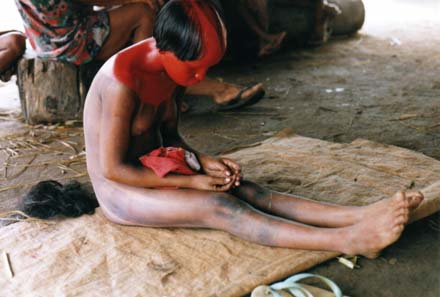| Return to main page |
Today I shall show you two short films about initiation. The first deals with a Catholic sacrament. It shows you how children aged only seven, boys and girls together, are taught not only the necessary doctrines but also the appropriate gestures and body movements to make their first holy communion. The second shows you a slightly older girl in an Amazonian society at the beginning of an initiation ritual. Please pay careful attention to all aspects of the process and make comparative notes in your journals.

Figure 35: A Panara girl, Central Brazil, being prepared for log racing on the occasion of her first menstruation (photo courtesy of Elizabeth Ewart)
Unfortunately the technology was faulty and the films could not be transmitted with sound. Ania felt that, even with the benefit of a detailed commentary, she would not have been able to make an effective comparison of the two, as Dr. Dylagowa wanted. For that she would have needed to interview the participants in the Amazonian case, to explore the girls' feelings as they received instruction from the elder women of the tribe, and to talk to them again in detail at the completion of the rituals. In the Polish case the lack of sound did not bother her at all, for she had been through very much the same rituals herself twelve years before. One of the nuns filmed teaching the catechism to the Polish village children looked uncannily like one of her own teachers in Slough.
Tom was utterly captivated by the Amazonian scenes. He could not help feeling that this was what real anthropology was all about. It was all very well to introduce Christian rituals for comparative purposes, but he himself would never be able to muster any enthusiasm for fieldwork 'at home'.
'When I started school the priest was not allowed to come to the primary school to give religious instruction,' said Maria later. 'We used to have to go the church twice a week after school, and sometimes on Saturdays as well. But since the end of communism the priests can teach inside the schools again, without restriction. One of the benefits of being back inside Europe.' Ania reflected that some countries of western Europe preferred to exclude religious education entirely from the state's curriculum.
Tom explained some of the debates that had been taking place on this topic in the United States. 'President Clinton has taken a strong personal interest. He says religion is important for the teaching of moral standards, so schools should not become 'religion-free zones'. But that's a big problem in practice, because we have a lot more religious diversity in America than you have here in Poland.'
Ania wondered if 'America' and 'Europe' were themselves 'multivocal symbols', understood in quite different ways, some of them definitely mythical, by different groups in Polish society. And it was suddenly clear to her that the equivalent of magic in modern capitalist societies was advertising, and that in some sense these societies were profoundly magical places.
| Return to main page |